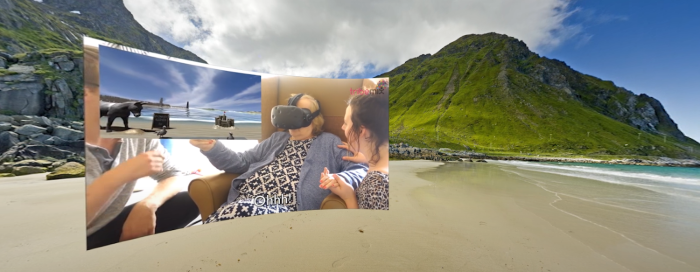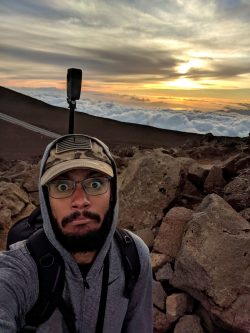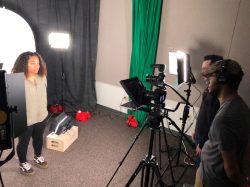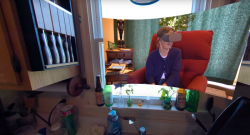Feature Friday: Video Production for Good – A Student Success Story
Posted on: February 4, 2022


As a JMU student, Sean Khuon-Paige (‘19) helped faculty to make videos as part of the Media Production Services (MPS) team in JMU Libraries. Now a freelance videographer in Portland, Oregon, he has worked on video projects for Netflix, Nike, Discovery Channel, and Google.
“That kick started my whole video career,” Sean recalls. “It was the first job I had doing video production. We basically coordinated with departments throughout JMU to help them make videos. There’s a studio in Rose Library where sometimes professors or staff would come in, and we would set up, you know, all the lights, cameras, everything, and film whatever they needed.”
Sean’s passion for storytelling through video drew him back to JMU after several years in the military to finish his studies in digital video and cinema. Now he works with Desert Island Studios, a collective of freelance filmmakers with a focus on social justice and telling the stories of underrepresented communities.
Let’s Meet Sean!
Tell us more about your video career in Portland!

“The Portland film community is like a miniature version of Hollywood. We may not have Hollywood-sized budgets, but there are a lot of people who are really passionate about storytelling. I have made a living now for the last year freelancing in the film industry. About half of my work is commercial, and the other half is smaller indie projects like short films and music videos. Nike’s World Headquarters is in Portland, so a good portion of my work is for them. I also recently worked on a Netflix food documentary as a camera assistant, which was insane, seeing how Netflix does things.”
How has it been different from what you expected?

“I’ve had a lot of really neat opportunities up here. Not anything that I thought it would be like after graduating and getting a film degree. At first I thought, ‘Yeah, I’m gonna go to LA and make big movies,’ and I’m not doing that at all. This is way more fun. Last year I joined Desert Island Studios, which is a whole collective of freelance filmmakers who focus on supporting underrepresented creatives. I did not think I would be getting this type of work within like a year or two of graduating, but I guess all of that networking really pays off. Now I have producer friends that will be like ‘Hey, there is this project coming up. Can you work on it?’ and I’m like ‘Uhh, yes!?'”
Now that you’re in Portland, what Harrisonburg restaurant do you miss the most?
“Sushi Jako, by far. The owner is really friendly and the sushi is amazing. My partner and I went there once every couple of weeks. You have to try their Don Katsu, it’s the best thing on their menu!”
Okay, so tell us more about your job as a student in the Libraries!
“I was a Media Production Assistant with Jenna Polk [Media Specialist] on the Media Production Services team in JMU Libraries. Working at MPS was like the mini collegiate trial run of basically what I do now. I do every aspect of filmmaking, even setting up all of the lights.”

What was your favorite project you worked on?
“I recorded one or two events for the Furious Flower Poetry Center, and I was like, ‘Oh wow, this is really cool. I didn’t know poetry was cool!’ I would have never gone to a poetry anything in my spare time, but going to it for work was a great opportunity. They’re a bunch of really talented people that gave me a better appreciation for poetry. Furious Flower was dope.”
What else did you experience in the Libraries besides your job?
“Ivan [Guadarrama, Instructional Media Consultant] is awesome. I was in a brand new film studies class taught by Dennis Lo–it was the first of its kind–and we had to make our own five-minute virtual reality film. Ivan gave us several tutorials and classes on how to use these 360 GoPro cameras. Then we used The Makery in the bottom of Carrier [Library] that had all the different VR equipment to make our films and edit them. It was by far the hardest class I ever had to take, but it was so cool. I don’t know anyone else that got to do anything like that, and that would not have been possible without Ivan. He taught us so much. So that was like the main project, and it was showcased in the library.”

That’s really awesome! What was your virtual reality 360 video about?
“Whoo! My video was on the therapeutic effects of VR. So there are a lot of studies where they bring VR goggles into nursing homes and let people use them as a way to get out of the nursing home because a lot of people were either immobile or in wheelchairs. So these elderly people would put on VR headsets and then be transported to like the plains of Africa or something. It helped them a lot. People could take pictures and send them to their relatives, and it could be like a 360 picture of families in their living room or whatever, so you could send like a virtual Christmas card–things like that. So it was mainly on the immersiveness and how people could use VR for good, rather than whatever Facebook and Meta are doing now.”
Can we watch your VR video in 360?

“Yeah, my project was called Virtual Remedy. If you don’t have a headset, YouTube allows you to if you full screen it, so you can click and scroll in 360 as well. I filmed it at my grandmother’s house. I filmed her putting the headset on and then different scenes around her house, and she had a blast doing it. You can scroll and see my grandma’s dog and cat in her house. I grew up in that house, so it’s like it’s a really nostalgic little piece for me.”
So…how do you make a video in virtual reality?
“So we had to use these GoPro Fusion cameras. They have a big 180 degree camera on the front and one on the back. You place it on a tripod, and then it records 360 degree video and audio, too, so if you’re on one side of the camera and you have stereo headphones on, it sounds like it’s coming from over here or over there. It was awesome because these types of cameras were just released and JMU bought like 10 of them for us to use.”
Was there anything else you wanted to share about your time at the Libraries?

“I don’t think too many people know about The Makery with all the 3D printers and beanbags and projectors. That’s where all the VR gear is. More people need to go to The Makery and make things. The Makery is cool as hell, and [Grover Saunders, Head of Makerspace Services] who’s a SMAD professor and he’s got all the figurines, he’s awesome. The Makery was like my home for two semesters. I guess there’s one in Rose [Library] now too, right? Just go hang out in The Makery and either 3D print some stuff or check out the VR games and movies because it’s pretty mind-blowing.”
What message would you like to share with everyone at JMU?
“Sharing stories, whether that’s in like a visual medium or through poetry or through Zoom–one on one or with a larger audience–is one of the best things ever. It is one of the greatest gifts that we can give and receive as humans. So, share more stories and tell more stories when you can. It makes you a better human. I feel like a lot of people, when they’re watching movies, they’ll be like, ‘Oh my God, that was so good!’ and they’re like crying, but they don’t realize why. It’s because a lot of people pour their heart and soul into researching and documenting and figuring out what story they want to share with the world. That’s why. So, filmmaking is dope and poetry and all forms of art are great, but sharing stories makes us more empathetic and better humans, I think. So keep doing that, people of JMU. Keep doing that.”
This story is part of the JMU Libraries Feature Friday story series. Check out Sean Khuon-Paige’s professional portfolio to learn more about his work.
Categorised in: Educational Technology News, Feature Friday, Giving to JMU Libraries News, JMU Libraries News, The Makery News